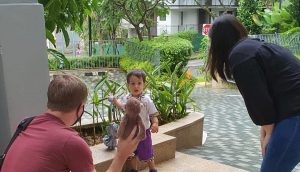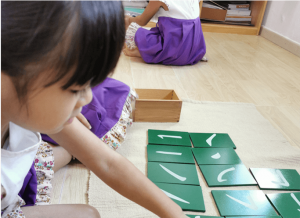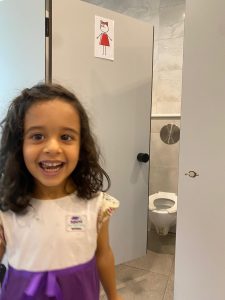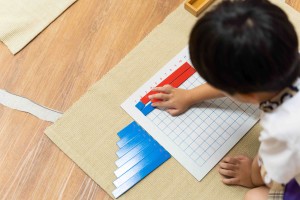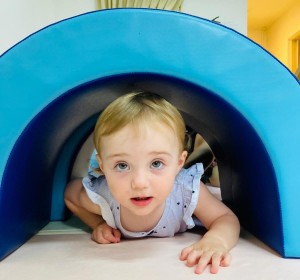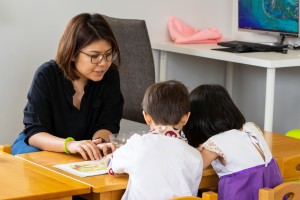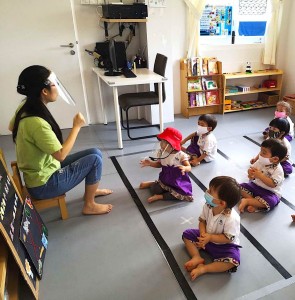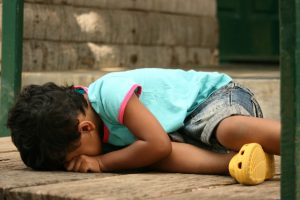
How to Handle Your Toddler’s Challenging Behaviour
“Oh no, my child is throwing a tantrum again!” This is what runs through the mind of many parents when their children display behaviours which are difficult to cope with. Understanding Your Toddler’s Growing Awareness The thing is, your little baby is no longer an infant whom you can redirect their misguided behaviours easily. They are now toddlers who are beginning to gain consciousness of their surroundings and possess the capability of holding their thoughts for a longer period. At this stage in their development, young children will begin to seek out the reasons for why things are the way they are and will start to test the limits. Unfortunately for parents, children at this age haven’t acquired the ability to understand why adults are saying ‘no’ to them yet! Guiding Behaviour with ‘What, When, and Where At House on the Hill, our teachers are trained to intervene and create opportunities to teach our young ones the “What, When, and Where” expectation. These expectations lead the child to understand that we do things at the right place and time. For example, we do not wear a cardigan or jacket just because we like it, but that the outfit is worn when we feel cold and are not able to manipulate the temperature. With consistent guidance in the order of “what, when, and where”, experiencing limits and order develop the toddler’s will. When this is internalised, the toddler will have the capability to control their behaviour. 4 Beautiful Locations Islandwide At House on the Hill, we strive to embody the true Montessori method and philosophy in every lesson and activity. Book A Tour The Montessori Approach: Freedom within Limits ‘Freedom within limits’ is a common term used in Montessori, advocating for defining and setting clear expectations and ground rules. Ground rules stem from three basic ground rules – Respect for oneself, Respect for others, and Respect for the environment. In school, we encourage children to respect the rules of their freedom. To share my personal experience; I’m a parent to a 3-year-old child who constantly tests the limits, such as jumping over his 7-month-old sister. When this happens, I will remind him of the possible dangerous outcomes of jumping over her. At this point, I will recognise his need to jump and at the same time exploring alternative options with him to do so in a safe environment. Lastly, I will also set the consequence with him to say that if he continues to jump over her, I will proceed to separate them by moving him away from his sister or moving his sister to a safer environment. When adults view toddler’s behaviour as challenging, it is always about finding the right balance between the children’s and parent’s needs. By recognizing the children’s needs and redirecting it to meet parents’ needs, we begin to reduce the power struggles between adults and toddlers. Start by recognising his needs by saying, “I see that you want to jump but jumping over your sister is not safe. I need to keep you both safe.” Then suggest alternatives for him or we can even get him to provide the suggestions, “Let’s get a block or mat and you can jump over that instead.” Hence, with appropriate strategies, challenging behaviours can be overcome! Here are a few suggestions for consideration: Prevention Set aside time to have fun together, this helps your child to bond with you. Encourage appropriate specific behaviour (such as recognising positive actions, “I can see that you are sharing your toy”). Identifying triggers at an early stage can head off challenging behaviours. Create consistent routines. It helps when the child knows what’s coming next. Tackling the meltdown (with BREATHE) Be clear with limits set and guide your child’s behaviour by telling them what to do instead of what not to do. Restrain the child physically gently but firmly instead of reacting to physical outbursts from your child. It is good to maintain the boundary set to show that the child is not being punished but that the behaviour will not be tolerated. Easy and clear instructions for the child to follow if they decide to communicate. Allow an alternative to the situation but it is the child’s choice. Together, or if child is not willing, then demonstrate an example for the desired behaviour. This helps to makes them feel less isolated and overwhelmed, showing them that what they were asked to do is not scary or bad. Hug! Positive physical connection is grounding and calming for young children. Be sure to not force the hug. Allowing them to calm down puts the child back in control of their emotion. You will find the hug helps to slow your child’s heart rate and breathing, enabling the child to calm down. End with a recognition of the child’s positive behaviour! Do try these strategies in situations when you encounter your child displaying challenging behaviours that you have difficulty finding the right balance to meet both adult’s and child’s needs. Remember to always give the acknowledgement for children’s needs and providing them the perspective to understand the viewpoint of the adult’s. And of course always let the children know that mummy and daddy love them, to give the children the security and bond that parents are always here for them. . Remember to BREATHE! Works Cited Montessori Academy. (2017, February 8). Freedom within limits in Montessori Education. Ret Montessori Academy. (8 February, 2017). Freedom within limits in Montessori Education. Retrieved from Montessori Academy: https://montessoriacademy.com.au/montessori-freedom-within-limits/ Lillard, P., & Jessen, L. (2003). The Developing Will. In P. P. Lillard, & L. L. Jessen, Montessori From The Start (pp. 197-242). New York: Schocken Books. Theresa. (26 February, 2020). Freedom Within Limits. Retrieved from Montessori in Real Life!: https://www.montessoriinreallife.com/home/2020/2/25/freedom-within-limits Canadian Child Care Federation. (n.d.). Tips for Parenting Children with Challenging Behaviour. Retrieved from The Canadian Child Care Federation: Your ELCC Community: https://cccf-fcsge.ca/ece-resources/topics/challenging-child-behaviours-stress/tips-parenting-children-challenging-behaviour/ @jothemama, J. K. (18 June, 2021). How to be a gentle parent without letting your children walk all over you [Instagram IGTV]. Retrieved




